Decor
10 Stunning Ceiling Decorations for Your Living Room
Marvel at the transformative power of these 10 stunning ceiling decorations that will elevate your living room to new heights of elegance and charm.

As we explore the world of interior design, it's fascinating to note that ceilings often account for up to one-sixth of a room's total surface area, yet they are frequently overlooked in the design process.
The impact of a well-designed ceiling decoration cannot be underestimated, setting the tone for the entire living room space. From exposed wooden beams exuding a rustic charm to intricate molding details adding a touch of elegance, the possibilities are truly enthralling.
Join us as we unravel a curated list of 10 stunning ceiling decorations that will transform your living room into a space of unparalleled beauty and style.
Key Takeaways
- Well-designed ceiling decorations set the tone and ambiance of your living room.
- Architectural details like coffered and vaulted ceilings enhance sophistication and charm.
- Decorative lighting fixtures create striking focal points and elevate the room's style.
- Textured ceiling finishes offer visual interest and transform the overall ambiance of the space.
Exposed Wooden Beams
When we envision a cozy and stylish living room, exposed wooden beams immediately come to mind, adding a touch of rustic charm and architectural flair to the ceiling. These exposed beams not only elevate the room's design but also create a sense of warmth and character that's hard to replicate with other ceiling treatments. The natural texture of the wooden beams brings a unique visual appeal, making the ceiling a focal point of the room.
Incorporating exposed wooden beams is a design choice that can seamlessly blend with various styles, from traditional to modern. The versatility of wooden beams allows for customization through staining or painting, enabling them to harmonize with the overall aesthetic of the room. Whether you prefer a more rustic look or a sleeker finish, exposed beams can cater to your design preferences while still offering that cozy ambiance that every living room craves.
Ornate Molding Details

Elevating the ceiling's allure to new heights, ornate molding details infuse sophistication and elegance into your living room space. The intricate designs of ceiling moldings create a luxurious and upscale feel, enhancing the architectural features of the room. Here are three reasons why ornate molding details are a must-have for a stylish living room:
- Focal Point: Ornate ceiling moldings serve as a mesmerizing focal point, drawing the eyes upward and adding a touch of grandeur to the space.
- Cohesive Look: Matching the ceiling molding with other design elements such as furniture and decor items helps in creating a cohesive and polished look throughout the room.
- Upscale Feel: The ornate details of the ceiling molding exude an air of sophistication and elegance, elevating the overall aesthetic of the living room to a new level of luxury.
Decorative Lighting Fixtures
Enhancing the allure of your living room with sophisticated decorative lighting fixtures can instantly elevate the ambiance and style of the space. When it comes to ceiling design, incorporating unique light fixtures like chandeliers or pendant lights can create striking focal points that draw the eye upward. These decorative lighting fixtures not only provide ambient lighting but also contribute to the overall design theme of your living space.
Choosing lighting fixtures with intricate designs or artistic elements can add a touch of elegance to your room. The right placement of these fixtures can work wonders in creating a warm and inviting atmosphere. By selecting lighting elements that complement your design theme, you can achieve a cohesive and stylish look that showcases your personality.
Incorporating decorative lighting fixtures into your living room not only serves a functional purpose but also adds a layer of sophistication and visual interest to the space. Make a statement with your ceiling lighting and watch as it transforms your living room into a chic and elegant retreat.
Colorful Ceiling Designs
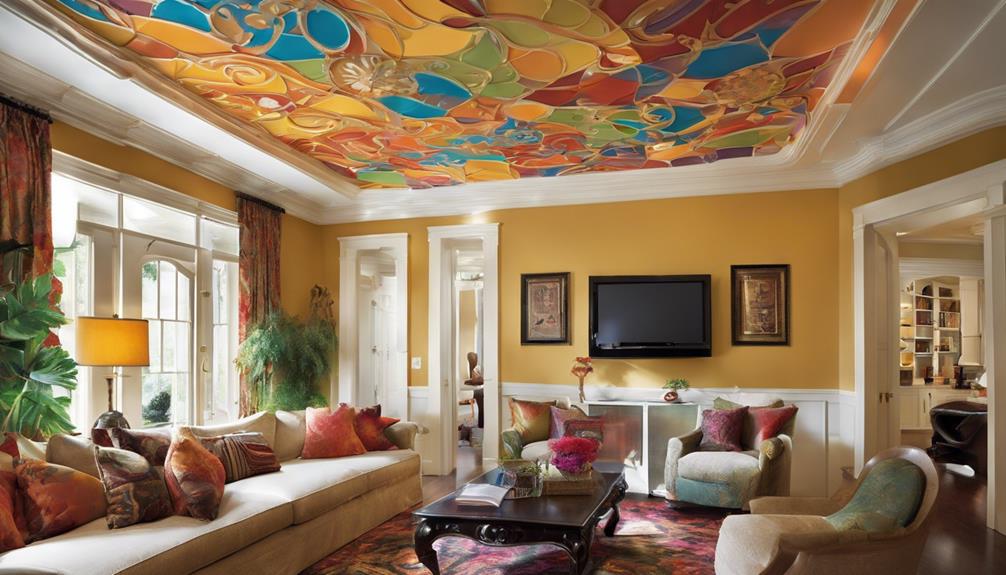
With a splash of color, your living room's ceiling can become a vibrant and personality-filled focal point. Here are some ideas to make your ceiling pop:
- Bold Hues: Consider painting your ceiling with striking colors like sky blue or deep red to create a visually mesmerizing atmosphere in your living room.
- Patterns and Geometric Shapes: Incorporating patterns or geometric shapes on the ceiling can add a modern and artistic touch to the space, making it stand out.
- Contrasting Colors: Experiment with riveting colors to make the ceiling design even more dynamic. Pairing colors that are opposite on the color wheel can create a bold and unique look that adds depth to the room.
Elegant Coffered Ceilings
Let's talk about the classic elegance of coffered ceilings.
These ceilings feature intricate grid patterns and timeless architectural detail that can elevate the look of any living room.
With their sophisticated design and customizable options, coffered ceilings bring a touch of luxury and charm to your home.
Classic Grid Patterns
Incorporating classic grid patterns, known as coffered ceilings, into your living room design elevates the space with timeless elegance and sophistication. These ceilings feature recessed panels or beams arranged in a grid pattern, adding depth and visual interest while creating a sense of spaciousness.
Here are some key points to take into account when opting for coffered ceilings:
- Customization: Coffered ceilings can be tailored with different panel sizes, shapes, and finishes to match various design styles effortlessly.
- Aesthetic Appeal: Popular in traditional and formal living rooms, coffered ceilings enhance the overall elegance of the space.
- Timelessness: The grid pattern of coffered ceilings ensures a classic look that never goes out of style, offering a sophisticated touch to any room.
Timeless Architectural Detail
Elegant coffered ceilings infuse a living room with a timeless architectural charm, elevating the space to new levels of sophistication and depth. These ceiling designs feature sunken panels that not only add visual interest but also create a sense of luxury.
The customization options for coffered ceilings are endless, allowing for various panel shapes and sizes to suit different interior styles, from traditional to modern. The intricate details of coffered ceilings draw the eye upwards, making the room feel more spacious and elegant.
Whether you prefer a classic or contemporary look, coffered ceilings can seamlessly blend into your living room, enhancing its overall aesthetic appeal with a touch of architectural finesse.
Artistic Ceiling Statements
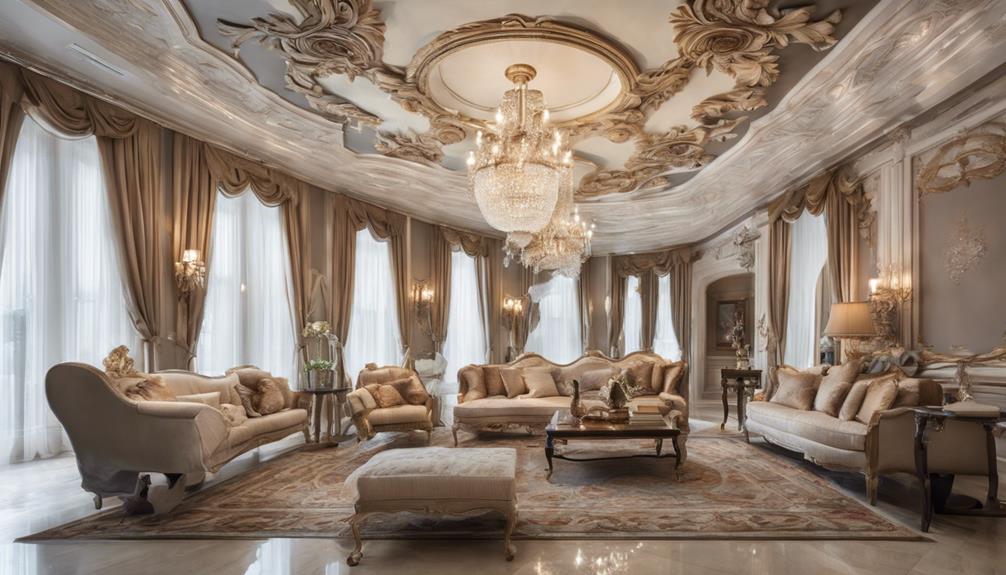
Let's talk about making a statement with our ceilings!
Unique ceiling murals can transform a plain ceiling into a mesmerizing piece of art.
Modern light fixtures and architectural details can further enhance the overall aesthetic of our living space.
Unique Ceiling Murals
Transform your living room's ambiance with the stunning allure of distinctive ceiling murals, making a bold artistic statement that elevates the space to new heights. Ceiling murals serve as custom-designed artistic statements that can completely transform the visual appeal of your living room.
Here are three ways these unique decorations can enhance your space:
- Nature-Inspired Designs: Bring the outdoors inside with a nature-inspired ceiling mural, featuring serene landscapes, lush forests, or calming seascapes.
- Focal Point Creation: Make the ceiling the focal point of the room by incorporating a striking mural that draws the eye upward, adding a touch of creativity to your living space.
- Enhanced Depth and Height: By choosing the right mural design, you can create an illusion of depth and height, making your living room feel more spacious and open.
Modern Light Fixtures
Drawing inspiration from the alluring allure of unique ceiling murals, we now shift our focus to modern light fixtures as artistic statements that illuminate and elevate your living room's aesthetic appeal.
Modern light fixtures offer a contemporary touch, enhancing the overall ambiance of the space. Opting for unique designs such as geometric shapes or sleek metallic finishes can create a striking focal point in your room.
LED fixtures aren't only energy-efficient but also provide customizable lighting options to suit different moods. By incorporating dimmable features, you can effortlessly set the desired ambiance for various occasions, making your living room a versatile and stylish space that reflects your modern taste in interior design.
Architectural Details
Enhancing your living room with alluring architectural details on the ceiling elevates the space to new levels of sophistication and charm. When considering artistic ceiling statements, incorporating elements like coffered ceilings, vaulted ceilings, and exposed beams can add depth and character, creating a visually alluring environment.
Statement ceilings with intricate molding patterns bring a touch of elegance and refinement to the room, while serving as focal points that spark conversations. These architectural elements not only enhance the overall design aesthetic but also introduce a sense of luxury and uniqueness to your living space.
Embracing artistic ceiling treatments is a trend that can transform your room into a stylish sanctuary that exudes creativity and innovation.
Textured Ceiling Finishes
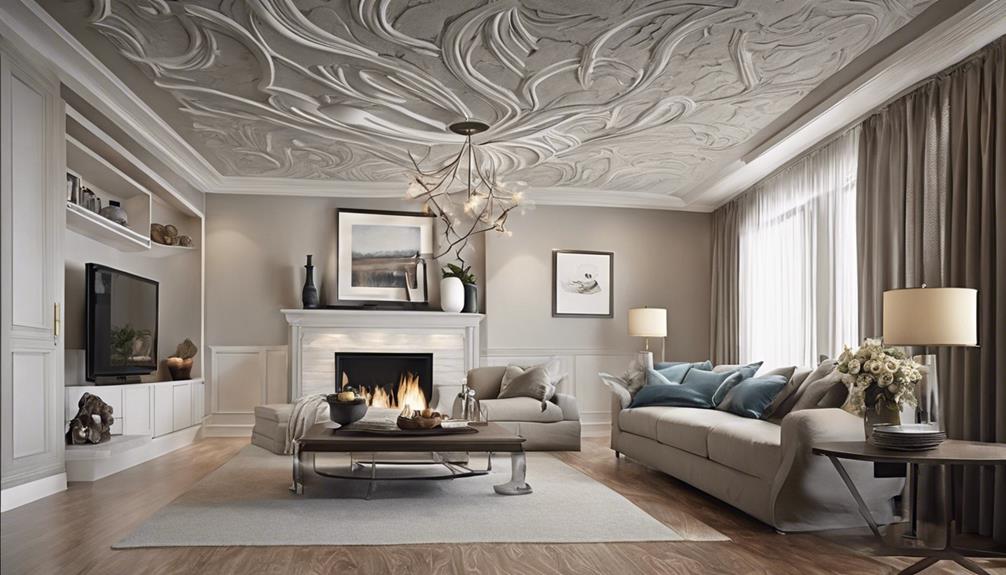
Adding a textured finish to your living room ceiling creates a mesmerizing visual depth and dimension, elevating the overall design aesthetic of the space. Different textures such as smooth, rough, or patterned ceilings can infuse visual interest and break up a plain ceiling, adding a unique design element. Textured finishes like popcorn ceilings, stucco finishes, or decorative plaster offer options for a personalized touch that can enhance the room's aesthetic and complement various decor styles.
| Ceiling Finish | Description |
|---|---|
| Popcorn Ceilings | Popular for their bumpy texture, they add a cozy and casual feel to the room. |
| Stucco Finishes | Mimicking the look of traditional stucco, these finishes bring a rustic charm. |
| Decorative Plaster | Intricate designs and patterns are possible, offering a touch of elegance. |
These textured ceiling finishes not only provide a tactile experience but also play a significant role in transforming the ambiance of your living room.
Architectural Ceiling Enhancements
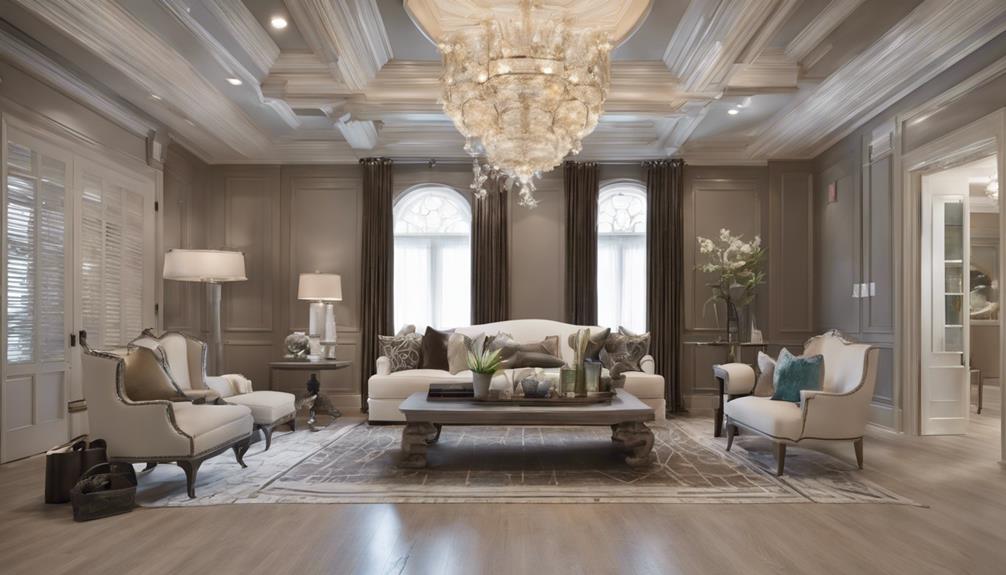
Venturing beyond textured finishes, we explore the domain of architectural ceiling enhancements that elevate the aesthetic appeal of a living room.
- Coffered Ceilings: Adding classic elegance and interest, coffered ceilings bring a touch of sophistication to your living space.
- Exposed Beams: For those seeking a rustic charm and character, exposed beams are the perfect choice to infuse warmth into the room.
- Vaulted Ceilings: Providing a sense of spaciousness and airiness, vaulted ceilings open up the room, creating a grand and expansive feel.
In addition to these enhancements, incorporating wainscoting on the ceiling can enhance the walls with decorative paneling, adding depth and texture to the overall design.
To further elevate the ambiance, consider adorning the ceiling with a crystal chandelier, infusing the space with glamour and luxury. These architectural additions not only elevate the visual appeal but also contribute to a sense of grandeur and style in your living room.
Skylight and Mood Lighting

Amidst the allure of natural light and customizable ambiance, skylights and mood lighting intertwine to sculpt a mesmerizing living room atmosphere. Skylights flood the space with invigorating natural light, creating a bright and airy feel while reducing the reliance on artificial lighting during the day, ultimately helping to save on energy costs. Pairing skylights with dimmable fixtures for mood lighting enhances comfort and relaxation, allowing you to tailor the lighting to suit different activities or times of day. The synergy between skylights and mood lighting results in a versatile lighting scheme that can adapt to your needs, whether you seek a cozy evening ambiance or a well-lit space for daytime activities. Check out the table below for a visual breakdown of how skylights and mood lighting can transform your living room:
| Benefits of Skylights | Benefits of Mood Lighting |
|---|---|
| Abundant natural light | Customizable ambiance |
| Energy cost savings | Enhanced comfort and relaxation |
| Versatile lighting scheme | – |
Patterned Ceiling Treatments
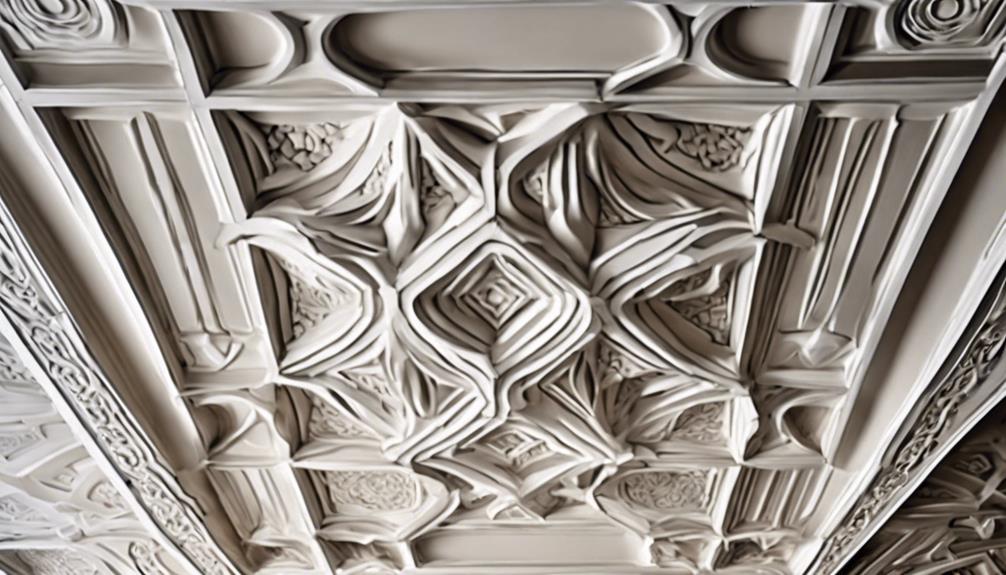
Let's discuss how geometric ceiling designs, floral ceiling patterns, and textured ceiling finishes can enhance the look of your living room.
These intricate patterns can bring a touch of modern flair or classic elegance to your space.
Geometric Ceiling Designs
Geometric ceiling designs in a living room infuse a contemporary flair, elevating the space with artistic sophistication. When considering geometric patterns for your ceiling, think about incorporating designs like chevron, herringbone, or hexagons to create visual interest. These shapes not only add a modern touch but also have the potential to make the room feel more spacious and dynamic.
Achieving these geometric ceiling treatments through paint, wallpaper, or molding allows for a customized look tailored to your style preferences. The versatility of geometric designs guarantees they can seamlessly complement various interior styles, providing a visually striking focal point in your living room.
Floral Ceiling Patterns
Adorning your living room ceiling with intricate floral patterns instantly elevates the space, adding an element of elegance and sophistication to the room's ambiance. Floral ceiling decorations create a visually stunning focal point, with soft and subtle floral motifs enhancing the overall charm of the living area. Achieving these beautiful floral patterns can be done through various techniques such as wallpaper, stenciling, or hand-painted designs. Bringing elements of nature indoors, these patterns evoke a sense of tranquility and serenity. To give you a glimpse of the possibilities, here's a table showcasing different ways to incorporate floral patterns into your ceiling decor:
| Technique | Description | Emotion |
|---|---|---|
| Wallpaper | Easy application | Elegance |
| Stenciling | Customizable designs | Sophistication |
| Hand-painted | Artistic and unique | Tranquility |
Textured Ceiling Finishes
Elevating the allure of your living room's ambiance, textured ceiling finishes introduce a mesmerizing dimension through intricate patterns and designs. These finishes not only add depth but also create visual interest, making your ceiling a focal point of the room.
Here's how textured ceiling finishes can transform your living space:
- Different textures like raised patterns or embossed finishes offer a dynamic and engaging look.
- Textured ceiling treatments can cleverly conceal any imperfections or uneven surfaces, giving your ceiling a flawless appearance.
- Techniques such as stenciling, embossing, or using textured paint allow for endless creativity and customization, resulting in stunning ceilings that elevate the overall aesthetic of your living room.
Frequently Asked Questions
How to Decorate a Living Room Ceiling?
We love to decorate a living room ceiling by incorporating exposed beams, unique painting techniques, and different materials for texture. Experimenting with architectural styles like vaulted ceilings and coordinating with lighting choices creates a visually appealing ambiance.
How Can I Make My Ceiling More Interesting?
To make our ceiling more interesting, we can explore coffered ceilings for architectural appeal, shiplap for rustic charm, vaulted ceilings for airiness, exposed beams for elegance, and wainscoting for a touch of sophistication. Let's elevate our living room!
What Is the New Style for Ceilings?
We've noticed a shift towards monochromatic statement ceilings, enhancing the cozy feel of a space. Natural wood ceilings bring warmth and character, while classic coffered molding ceilings offer a timeless elegance. Black-and-white design schemes create a bold, modern aesthetic.
How Can I Make My Ceiling Attractive Without False Ceiling?
We can enhance our ceiling's appeal without a false ceiling by incorporating decorative elements like medallions, crown molding, wallpaper, unique paint colors, and architectural details. These additions bring sophistication, visual interest, and personality to the room.
Conclusion
Just like the sky above us, the ceiling of a living room holds endless possibilities for creativity and beauty.
By incorporating stunning ceiling decorations such as exposed wooden beams, ornate molding details, and colorful designs, you can elevate the ambiance of your space to new heights.
Let your imagination soar as you transform your ceiling into a work of art, adding depth and character to your living room that will leave guests in awe.
Dare to dream big and look up!
- About the Author
- Latest Posts
Introducing Ron, the home decor aficionado at ByRetreat, whose passion for creating beautiful and inviting spaces is at the heart of his work. With his deep knowledge of home decor and his innate sense of style, Ron brings a wealth of expertise and a keen eye for detail to the ByRetreat team.
Ron’s love for home decor goes beyond aesthetics; he understands that our surroundings play a significant role in our overall well-being and productivity. With this in mind, Ron is dedicated to transforming remote workspaces into havens of comfort, functionality, and beauty.
Decor
Master Antiquing With Chalk Paint in 5 Steps
Start your journey to mastering antiquing with chalk paint in 5 steps and transform your furniture into vintage treasures.
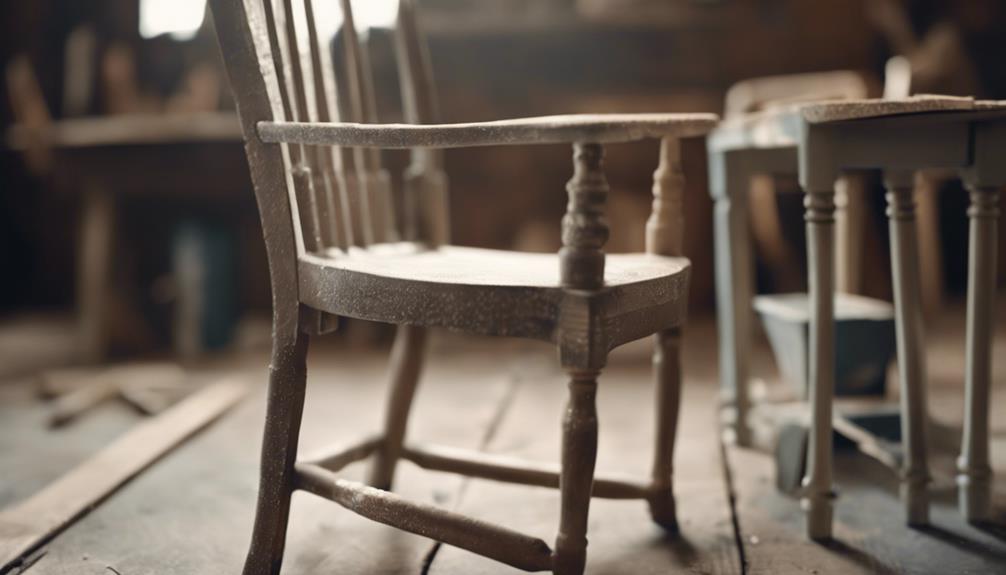
Master antiquing with chalk paint in 5 steps involves thorough surface cleaning, applying chalk paint in thin coats, distressing for a vintage look, sealing with a wax or polyurethane finish, and exploring different distressing techniques. Prepare by cleaning and sanding the surface, then choose high-quality paint and brushes for application. Experiment with dry and wet distressing, and seal the finish to protect against chipping and fading. For unique finishes, mix distressing methods and select the right sealant based on desired outcome. Mastering chalk paint antiquing takes practice and attention to detail, ensuring a beautifully aged furniture look.
Key Takeaways
- Choose high-quality chalk paint for best results.
- Apply thin, even coats for a smooth finish.
- Experiment with distressing techniques like dry or wet distress.
- Seal the finish with wax or polyurethane for durability.
- Practice and refine distressing skills for a masterful antique look.
Preparation
Before distressing furniture with chalk paint, we make sure to thoroughly clean the surface and lightly sand any rough spots for a smoother finish. This step is essential in achieving a professional-looking result.
Cleaning the furniture surface with White Lightning or TSP Degreaser helps remove any dirt, grease, or other contaminants that could interfere with the adhesion of the chalk paint. Using a lint-free cloth ensures that the surface is free of any residue that could affect the paint application.
Additionally, lightly sanding the furniture helps create a clean and smooth surface for the chalk paint to adhere to evenly. This process also helps remove any existing imperfections, ensuring a flawless final result.
Proper preparation sets the foundation for successful distressing with chalk paint, allowing for a more authentic and aged appearance.
After distressing, sealing the piece with a clear wax coat will protect the finish and enhance the overall look of the furniture.
Applying Chalk Paint
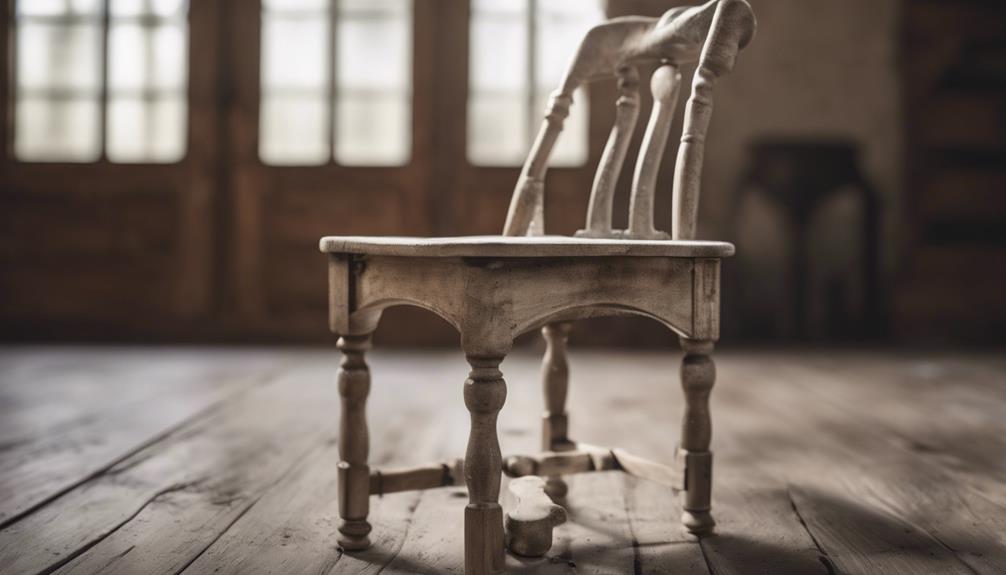
To achieve a professional finish with chalk paint, we recommend selecting a high-quality paint suitable for the specific furniture type.
When applying chalk paint, it's important to do so in thin coats to guarantee even application. Utilizing chalk paint brushes can help achieve better control and coverage.
It's vital to allow each coat of chalk paint to dry completely before applying the next one. This process helps prevent smudging and promotes a consistent finish.
Additionally, when starting a project, make sure you have enough chalk paint, typically a quart for larger pieces, to maintain color consistency throughout the furniture item.
Distressing Techniques
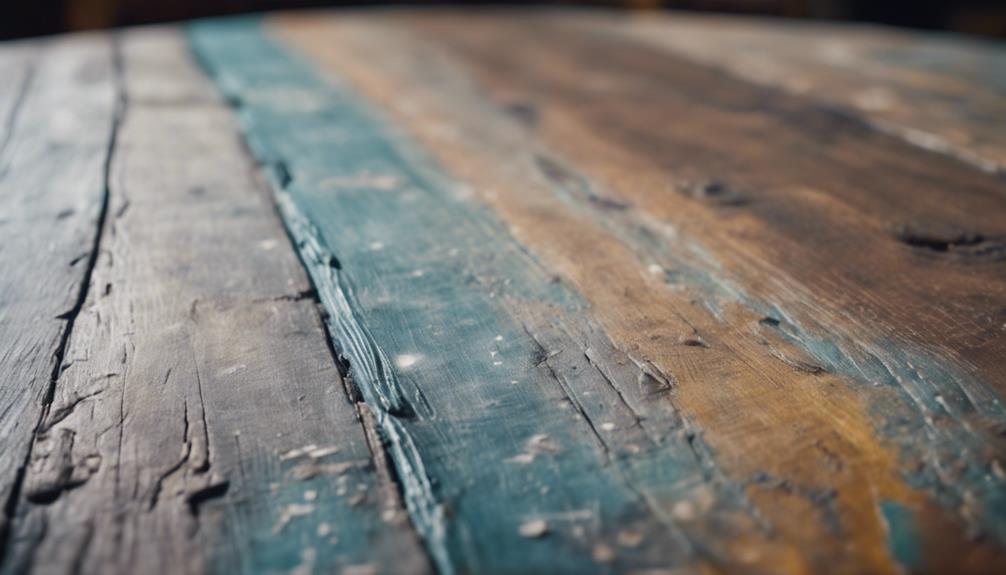
We can achieve various vintage looks by using different distressing techniques with chalk paint. Dry distress involves lightly sanding the chalk paint to reveal the underlying layers, creating a weathered appearance reminiscent of aged furniture.
On the other hand, wet distress requires wiping the chalk paint with a damp cloth to achieve a more natural, worn look. Wax distress, also known as the resist technique, utilizes wax as a barrier to create a subtle distressed effect on the furniture, adding depth and character to the piece.
Each distressing method offers a unique finish, allowing for experimentation and customization to achieve an authentic antique appearance. By trying out different distressing techniques, individuals can discover the method that best suits their desired vintage look.
Whether it's through sanding, wax resist, wet distress, or a combination of these methods, chalk paint provides a versatile medium for creating distinctive and aged finishes on furniture pieces.
Sealing the Finish

For achieving a durable and long-lasting distressed finish on furniture painted with chalk paint, selecting a high-quality clear wax or polyurethane sealant is essential. Applying a protective layer of sealant is vital to preserve the distressed look and prevent chipping or fading of the paint. It is recommended to apply the sealant in even coats to guarantee a smooth and lasting finish. Here is a comparison table to help you choose between wax and polyurethane sealants for your distressed furniture:
| Criteria | Wax Sealant | Polyurethane Sealant |
|---|---|---|
| Finish | Matte or Satin Finish | Glossy or Satin Finish |
| Durability | Requires Reapplication Over Time | Long-lasting and Durable |
| Application Ease | Easy to Apply, Buffing Required | Requires Thorough Application |
Both wax and polyurethane sealants offer protection and enhancement to your chalk-painted distressed furniture. Select the one that best suits your desired finish and maintenance preferences.
Chalk Paint Distressing Tips

Let's explore effective techniques for distressing chalk paint to achieve a vintage and worn look on furniture surfaces.
When aiming for a customized distressed finish, there are various distressing methods to choose from. Dry distress involves lightly sanding the chalk paint to reveal the base color underneath, offering a classic vintage appearance.
On the other hand, the wet distress technique includes wiping off the chalk paint with a damp cloth to create a natural worn effect.
For a more subtle distressed finish, consider using the wax distress or resist technique by applying wax to protect certain areas from paint.
Remember to protect the paint and preserve the finish by sealing distressed furniture with wax or polyurethane.
Frequently Asked Questions
How to Get an Antique Look With Chalk Paint?
To achieve an antique look with chalk paint, consider distressing techniques like dry distressing, wet distressing, or wax distress.
Dry distressing involves light sanding for a vintage appearance.
Wet distressing requires wiping the paint with a damp cloth for a natural worn look.
Wax distress, or resist technique, can create a subtle distressed effect on furniture.
Sealing the distressed piece with clear wax or polyurethane is essential to protect the finish and maintain the antique aesthetic.
How to Make Furniture Look Distressed With Chalk Paint?
To make furniture look distressed with chalk paint, we can use various techniques. Dry distressing involves lightly sanding the surface to reveal the base layer, creating a vintage effect.
Wet distressing entails wiping the paint with a damp cloth to expose the underlying color, achieving a natural worn look.
Wax distressing, known as the resist technique, uses wax to create a subtle distressed effect.
These methods offer unique ways to customize and achieve a distressed look with chalk paint.
How Do You Chalk Paint Step by Step?
We begin chalk painting by cleaning and lightly sanding the furniture surface.
Next, select a high-quality chalk paint and apply it in thin, even coats.
Explore different distressing methods such as dry, wet, or wax distress.
Finally, seal the distressed furniture with clear wax or polyurethane for protection.
Following these steps attentively guarantees a successful chalk painting project with a beautifully antiqued finish.
Do I Distress or Wax First?
We recommend distressing before waxing when working with chalk paint for an authentic aged appearance. Distressing creates texture and depth, enhancing the final antique effect once sealed with wax.
Applying wax over distressed areas not only protects the finish but also accentuates the distressed look. Waxing before distressing can complicate the process as the wax may interfere with sanding.
Distressing first allows for better control over the furniture's final appearance.
Conclusion
To sum up, mastering antiquing with chalk paint is a fulfilling process that can transform ordinary furniture into stunning pieces with character and charm.
As the saying goes, 'A piece of furniture is like a blank canvas waiting to be brought to life.'
By following these 5 steps, you can discover the full potential of chalk paint and create unique and beautiful pieces that will stand the test of time.
Happy antiquing!
- About the Author
- Latest Posts
Introducing Ron, the home decor aficionado at ByRetreat, whose passion for creating beautiful and inviting spaces is at the heart of his work. With his deep knowledge of home decor and his innate sense of style, Ron brings a wealth of expertise and a keen eye for detail to the ByRetreat team.
Ron’s love for home decor goes beyond aesthetics; he understands that our surroundings play a significant role in our overall well-being and productivity. With this in mind, Ron is dedicated to transforming remote workspaces into havens of comfort, functionality, and beauty.
Decor
10 Steps to Painting a Plastic Frame
Uncover professional tips for transforming plastic frames with paint, ensuring a flawless finish and lasting results.
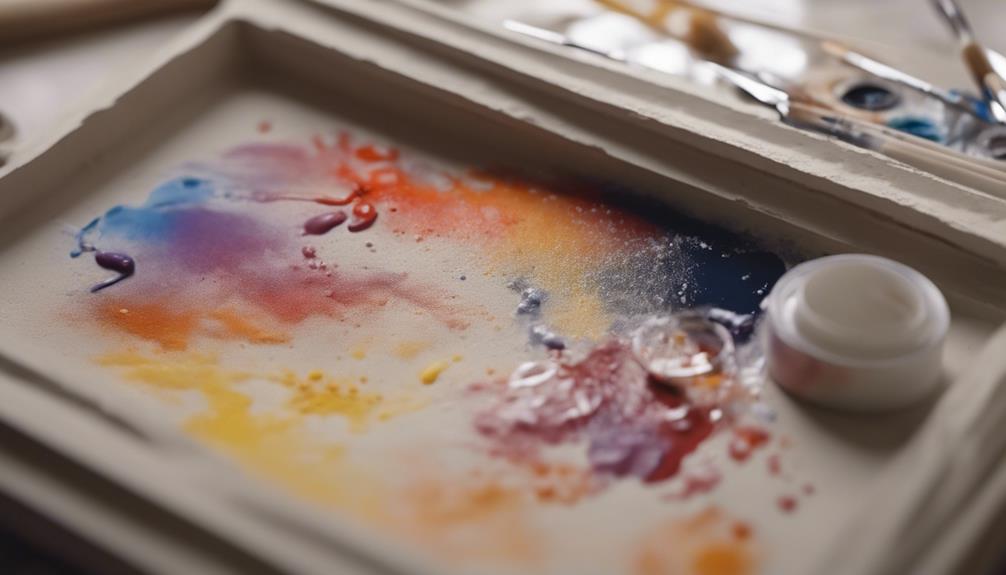
To paint a plastic frame effectively, start by selecting polypropylene or polyethylene frames. Clean thoroughly and lightly sand before applying a suitable primer. Use rubbing alcohol for a smooth finish, then mask off areas and apply even coats of paint with proper drying time. Add creative touches and seal with polyurethane for protection. This process guarantees a professional-looking result that lasts.
Key Takeaways
- Select plastic frames suitable for painting, avoiding PVC or polystyrene.
- Thoroughly clean and lightly sand the frame for adhesion.
- Apply a plastic-specific primer evenly after surface prep.
- Use painter's tape for clean lines and masking off.
- Seal with polyurethane for protection and finish longevity.
Selecting the Right Plastic Frame
When selecting a plastic frame for painting, make sure it's made of suitable materials like polypropylene or polyethylene for better paint adhesion. Different plastics have varying levels of compatibility with paint, so it's important to choose the right type to achieve best results.
Avoid using frames made of polyvinyl chloride (PVC) or polystyrene, as these materials may not allow the paint to adhere effectively, leading to peeling or flaking over time.
Certain types of paint may also work better with specific plastic frames. Checking the manufacturer's recommendations for the frame can provide valuable insights into which paints are most suitable for that particular material.
Opting for plastic frames specifically designed for painting can ensure a smoother process and a more professional finish.
Cleaning and Sanding the Surface

How should we prepare the plastic frame surface before painting to guarantee excellent adhesion and a smooth finish? To guarantee a successful paint job, follow these steps:
- Cleaning:
Begin by thoroughly cleaning the plastic frame to remove any dirt, dust, or grime. This step is vital as any impurities on the surface can affect the adhesion of the paint.
- Sanding:
Lightly sand the surface of the plastic frame to create a rough texture. This roughness provides a better grip for the paint, allowing it to adhere more effectively and prevent peeling or chipping.
- Primer:
Consider applying a suitable primer after cleaning and sanding the frame. A primer helps the paint adhere better to the surface and can also aid in achieving a smoother finish.
- Masking:
Before painting, make sure to mask off any areas of the frame that you don't want to paint. This step ensures clean and precise lines, giving your project a professional look.
Wiping Down With Rubbing Alcohol

We recommend wiping down the plastic frame with rubbing alcohol to guarantee proper adhesion and a smooth finish before painting. Rubbing alcohol plays a vital role in preparing the plastic surface for painting by effectively removing any dirt, oils, or residue that could hinder paint adhesion. This step ensures that the paint adheres well to the plastic surface, reducing the risk of peeling or flaking over time. The quick evaporation of rubbing alcohol leaves behind a clean and dry surface, ready for the next steps in the painting process.
To illustrate the importance of this step, let's take a look at the table below:
| Benefits of Wiping Down with Rubbing Alcohol |
|---|
| Removes dirt, oils, and residue from the plastic surface |
| Enhances paint adhesion for a smoother finish |
| Quick evaporation leaves a clean surface ready for painting |
| Prevents peeling or flaking of the paint over time |
| Effective and efficient preparation before priming or painting |
Masking Off Areas for Painting

When masking off areas for painting a plastic frame, it's essential to use painter's tape to guarantee clean lines and edges.
Make sure to press down firmly on the tape to avoid any paint bleeding onto unwanted areas.
Carefully mask off intricate details or sensitive parts to achieve a professional finish.
Taping off Edges
To achieve clean and precise lines in your painting, carefully use painter's tape to mask off areas of the plastic frame that you don't want to paint.
Here are some essential steps to follow when taping off edges:
- Prepare the Surface: Make sure the edges are clean and dry before applying the tape to promote adhesion and prevent paint seepage.
- Apply the Tape: Gently press the painter's tape along the edges of the areas you want to protect, ensuring it adheres firmly to the surface.
- Seal the Edges: Run your finger along the edge of the tape to secure it tightly to the plastic frame and prevent any paint from bleeding through.
- Double-Check: Before painting, inspect the taped-off areas to confirm that the edges are properly sealed and that there are no gaps where paint could seep under the tape.
Taking the time to tape off the edges meticulously will result in a professional and polished finish for your painted plastic frame.
Covering Sensitive Parts
Cover delicate parts like glass or hardware with masking paper or plastic before painting the plastic frame to protect them from unwanted paint.
When working on plastic frames, it's important to use painter's tape to mask off areas that shouldn't be painted. Make sure the painter's tape is firmly pressed down to create a tight seal and prevent any paint from seeping through.
In addition to using painter's tape, consider covering sensitive components such as glass or hardware with masking paper to safeguard them during the painting process. Taking the time to accurately mask off these areas will result in clean and precise paint lines, contributing to a professional-looking finish on your plastic frame.
Properly covering these sensitive parts is essential in achieving a polished and refined appearance for your painted plastic frame.
Applying a Suitable Primer
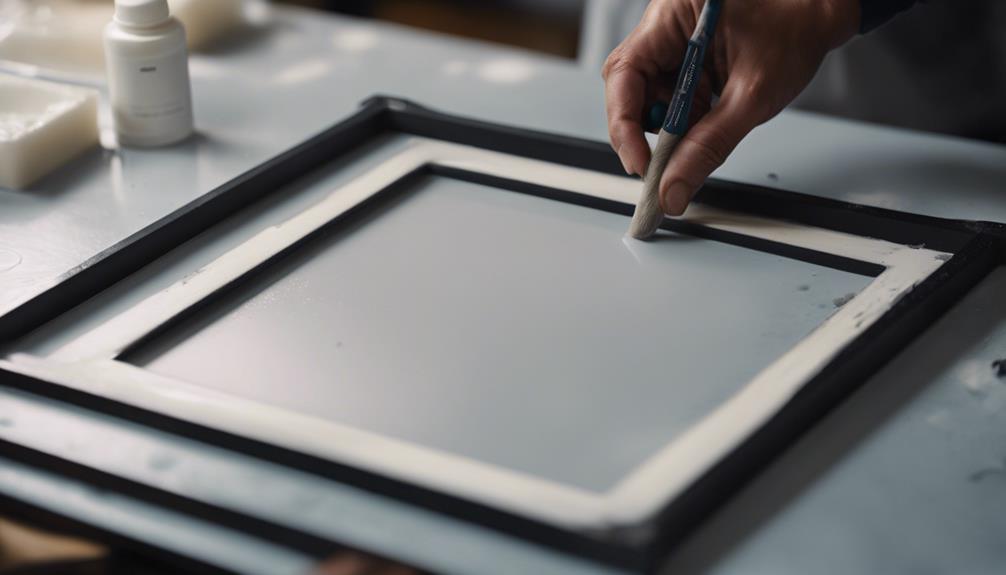
Let's kick off this step by prepping the plastic frame with a primer that's compatible with plastic surfaces. Here's what you need to know:
- Choose the Right Primer: Select a primer specifically designed for plastic frames to guarantee proper adhesion.
- Apply Evenly: Use smooth, consistent strokes to apply the primer evenly over the entire surface of the frame.
- Allow Sufficient Drying Time: Let the primer dry completely as per the manufacturer's instructions before proceeding with the next steps.
- Ensure Complete Coverage: Make sure the primer covers the plastic frame entirely to establish a strong base for the paint.
Using Appropriate Paint for Plastic

After preparing the plastic frame with a suitable primer, the next crucial step involves selecting the right paint specifically formulated for plastic surfaces.
When painting a plastic picture frame, it's vital to choose a type of paint that's designed to adhere to plastic materials. Using regular paints may result in poor adhesion, leading to peeling or chipping off easily. To guarantee a durable and long-lasting finish, opt for acrylic paint or other paints labeled for plastic surfaces. These specialized paints are formulated to bond effectively with plastic, preventing flaking and ensuring a smooth application.
Whether you prefer spray paints for a quick and even coverage or brush-on paints for more detailed work, selecting the appropriate paint for your plastic picture frame is key to achieving a professional-looking result.
Applying Even Coats of Paint
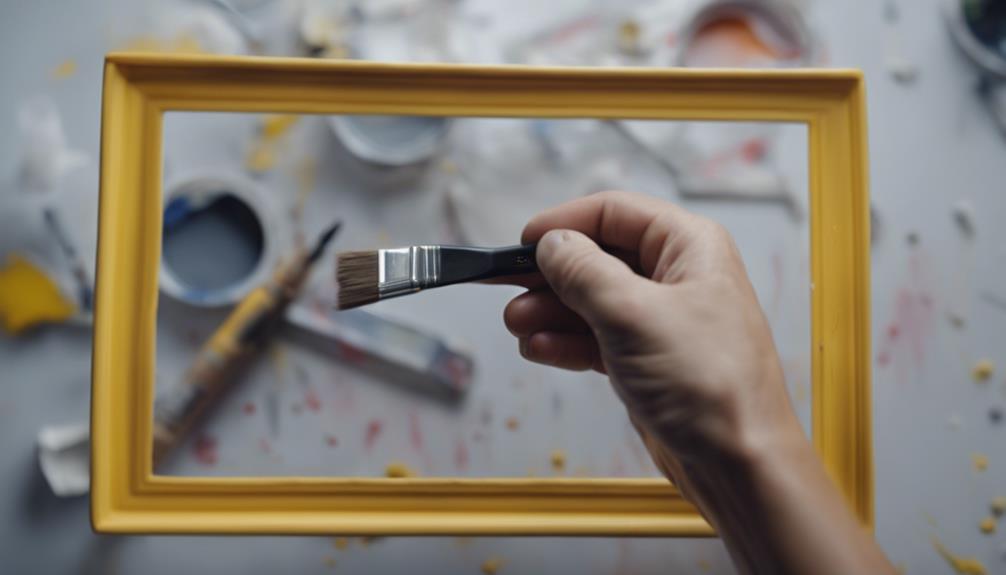
To achieve a smooth and professional finish on a plastic frame, it's essential to apply even coats of paint. When painting picture frames, following these guidelines guarantees a flawless result:
- Apply Thin and Even Coats: Each layer of paint should be applied thinly and evenly across the frame to prevent drips or uneven coverage.
- Allow Proper Drying Time: It's vital to let each coat dry before applying the next one. This helps the paint set correctly and adhere well to the plastic surface.
- Opt for Light Coats: Applying multiple light coats is preferable to a single heavy coat. This technique prevents clumping or streaking, resulting in a more uniform finish.
- Maintain Consistency: Consistency in paint application is key to achieving a uniform color and texture throughout the frame. Make sure to follow a systematic approach to ensure a professional-looking outcome.
Allowing Each Coat to Dry
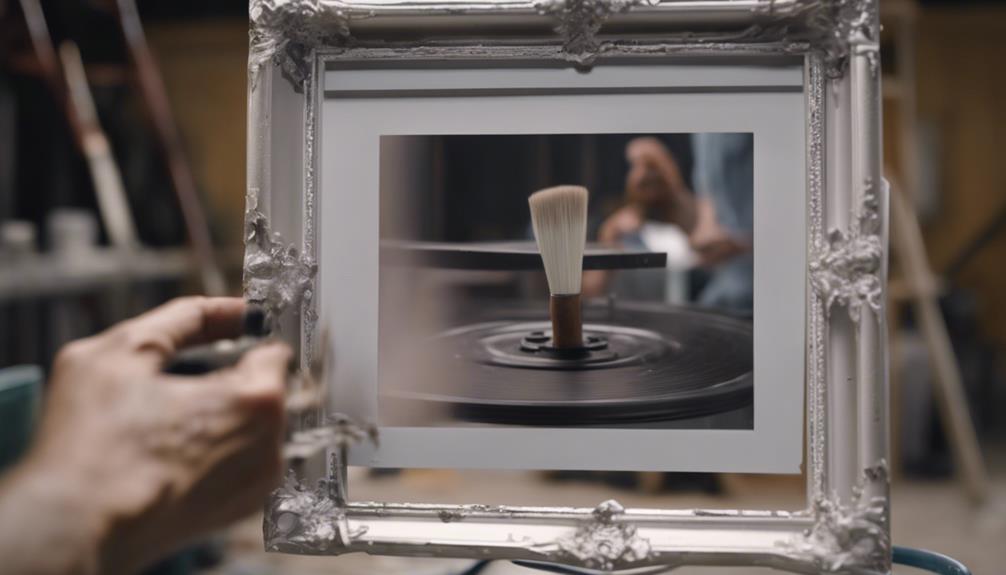
Guaranteeing that each coat of paint is thoroughly dried is a critical step in achieving a flawless finish on a plastic frame. By allowing sufficient drying time between coats, we can prevent potential issues like smudges, drips, or uneven application.
It's vital to follow the recommended drying times based on the type of paint utilized to secure the best results.
Patience for Drying Times
For best results, guaranteeing each coat of paint on the plastic frame dries thoroughly before applying the next coat is essential. Here are some key points to keep in mind:
- Prevent Smudging and Streaking: Allowing each coat to dry completely helps prevent unwanted smudges or streaks in the paint job.
- Refer to Manufacturer's Instructions: Drying times can vary depending on the type of paint used. Always refer to the manufacturer's instructions for specific guidance on drying times.
- Avoid Rushing the Process: Rushing the drying process can result in a less durable finish and potential imperfections. Patience is key for a flawless outcome.
- Achieve Professional Results: Patience during drying times ensures a smooth and professional-looking paint job on the plastic frame, leading to a high-quality and long-lasting finish.
Importance of Waiting
Allowing each coat of paint to thoroughly dry is crucial for achieving a flawless finish on a plastic frame. When painting a plastic frame, the significance of waiting between coats can't be emphasized enough.
Properly allowing each coat to dry guarantees that the paint adheres evenly, preventing issues like smudging, running, or uneven coverage. Rushing this process can lead to a less durable and professional-looking result, with potential peeling or chipping over time.
The drying time required between coats may vary depending on the type of paint being used, so it's essential to follow the specific instructions provided on the paint label. Patience is key in achieving a smooth and flawless paint job on your plastic frame.
Adding Touch-Ups and Details

We often enhance the visual appeal of the painted plastic frame by adding intricate designs or patterns using acrylic craft paint on rubber stamps for a personalized touch.
To add that extra flair, here are some tips for detailing your plastic frame:
- Create Stencils: Make stencils from contact paper or use pre-made ones to easily incorporate decorative elements onto the frame.
- Antiqued Look: Apply acrylic paint or tinted glaze to achieve a vintage appearance, enhancing the frame's visual appeal.
- Metallic Touch: Experiment with gold or silver glaze for an elegant and luxurious finish.
- Creative Touches: Utilize stamps, painted designs, or rubbed-on color to elevate the overall aesthetic of the frame.
Sealing With Polyurethane
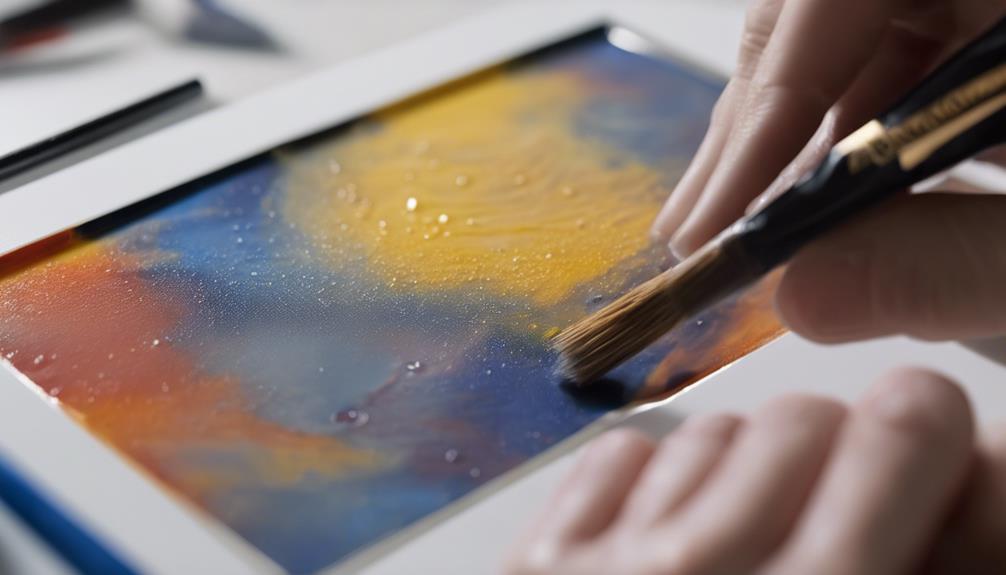
To protect and enhance the painted plastic frame, we recommend sealing it with polyurethane, a clear and durable sealant. Applying polyurethane over the painted surface not only provides protection against scratches, moisture, and UV rays but also helps to prolong the lifespan of the paint.
When selecting polyurethane, consider the different finishes available, such as matte, satin, semi-gloss, or glossy, to achieve the desired look for your frames.
To apply polyurethane effectively, make sure that the painted plastic frame has already received a coat of primer and is completely dry. Use a high-quality brush or foam applicator to apply thin and smooth coats of polyurethane to avoid streaks or bubbles. Allow each coat to dry thoroughly before adding additional layers.
Frequently Asked Questions
How to Paint a Plastic Frame?
When painting a plastic frame, proper preparation is essential. Sand the surface lightly and clean it with rubbing alcohol for better adhesion. Use a primer specifically formulated for plastic to make sure the paint sticks well.
Apply multiple thin coats of paint, allowing each layer to dry completely before adding more. Consider adding unique touches like stamps or antiquing for a personalized look.
Following these steps will result in a beautifully painted plastic frame.
What Paint to Use on Plastic Frames?
When painting plastic frames, it's important to select the right type of paint for excellent adhesion and durability. Utilizing paints specifically formulated for plastics guarantees a lasting finish.
Look for spray paints or brush-on craft paints labeled for plastic use. Consider using a plastic primer if the desired color is unavailable in the chosen paint type.
Adhering to these guidelines guarantees a successful painting project with vibrant and long-lasting results.
What Kind of Paint Will Stick to Plastic?
When considering what kind of paint will stick to plastic, it's important to choose a paint specifically designed for plastic surfaces. Regular brush-on or spray-on paints may not adhere well, leading to peeling or chipping.
Opt for spray paint formulated for plastic or use a plastic primer before painting to guarantee better adhesion. Acrylic craft paint can also be suitable for decorative purposes, but for a long-lasting finish, selecting the right plastic-specific paint is essential.
How Do You Prep Plastic for Paint?
When prepping plastic for paint, we must start by thoroughly cleaning the surface to remove any debris.
Light sanding helps the paint adhere better, and wiping with rubbing alcohol guarantees a clean canvas for painting.
Masking off areas we don't want to paint is vital.
Applying a suitable primer designed for plastic promotes paint adhesion and a smooth finish.
These steps are essential to achieve a professional-looking paint job on plastic surfaces.
Conclusion
In just 10 simple steps, you can transform a plain plastic frame into a personalized work of art.
By following these easy instructions, you can create a unique and custom piece that reflects your style and creativity.
So grab your supplies and get painting – the possibilities are endless!
- About the Author
- Latest Posts
Introducing Ron, the home decor aficionado at ByRetreat, whose passion for creating beautiful and inviting spaces is at the heart of his work. With his deep knowledge of home decor and his innate sense of style, Ron brings a wealth of expertise and a keen eye for detail to the ByRetreat team.
Ron’s love for home decor goes beyond aesthetics; he understands that our surroundings play a significant role in our overall well-being and productivity. With this in mind, Ron is dedicated to transforming remote workspaces into havens of comfort, functionality, and beauty.
Decor
How to Paint a Mirror Like a Pro in 3 Easy Steps
Find out how to transform your mirror into a masterpiece with these three easy steps that will elevate your space instantly.

Painting a mirror like a pro is simple in three steps. First, clean and trace the frame, then prime with gesso. Apply paint from the edges in thin layers using quality brushes. Opt for enamel or acrylic paint, allowing thorough drying between coats. Finish with sealant for protection. This process guarantees a flawless, professional look that enhances any space with elegance and style. Mastering these steps will help create a polished finish that transforms your mirror into a work of art.
Key Takeaways
- Use high-quality enamel or acrylic paint for a professional finish.
- Apply thin, even layers starting from the edges.
- Allow each coat to dry completely before adding another.
- Finish with a sealant or varnish for protection and longevity.
- Focus on details and take your time for a polished result.
Prepare Mirror Frame
Let's begin by cleaning the mirror frame with a soft cloth and window cleaner to remove any dirt or residue. Make sure to use rubbing alcohol or vinegar for tougher areas, guaranteeing the surface is completely clean before starting the painting process.
Once clean, trace the area to be painted on the mirror frame using a white soluble pencil for precise painting boundaries. This step is essential in achieving a clean and professional look for your mirror project.
Next, seal the mirror frame with white gesso as a primer to prevent paint peeling and ensure long-lasting results. This will create a smooth surface for the paint to adhere to, enhancing the durability of your design.
Additionally, consider using makeup pencils, white crayons, or fabric pencils for tracing intricate designs on the mirror frame before painting to achieve a detailed and polished final look. Make sure to take your time during this preparation process to guarantee a high-quality finish for your mirror frame project.
Apply Paint Evenly

To guarantee a smooth and professional finish, apply the paint evenly on the mirror surface using a high-quality paintbrush.
Here are some key tips to help you achieve a flawless coat of paint on your mirror:
- Start painting from the edges: Begin by carefully painting along the edges of the mirror frame before moving towards the center. This method ensures a consistent application and helps prevent any uneven patches.
- Work in thin layers: Avoid applying thick coats of paint as this can lead to drips and streaks on the mirror surface. Instead, opt for multiple thin layers, allowing each coat to dry completely before adding another one.
- Use a steady hand: When applying the paint, maintain a light touch and steady hand to achieve an even finish. This technique helps in creating a uniform look across the entire mirror.
Achieve Professional Finish
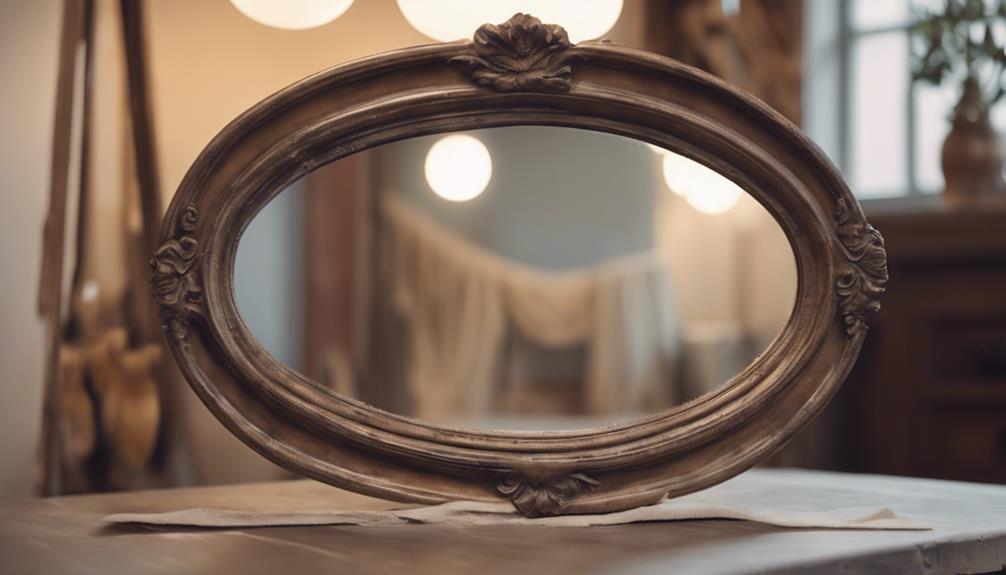
For a professional finish when painting a mirror, select high-quality enamel or acrylic paint specifically formulated for glass surfaces. To achieve a polished look, it is vital to apply thin coats of paint in even layers, allowing each coat to dry thoroughly before adding the next. This process guarantees a smooth and professional result on your painted mirror surface. Additionally, consider applying a sealant or varnish to protect the painted surface and enhance its longevity. Taking your time and paying attention to details will help you safeguard the painted surface and achieve a polished finish.
| Key Steps to Achieve Professional Finish |
|---|
| Choose high-quality enamel or acrylic paint designed for glass surfaces |
| Apply thin coats in even layers |
| Allow drying time between coats |
Frequently Asked Questions
How to Do Mirror Painting?
When tackling mirror painting, selecting the correct acrylic paint designed for glass surfaces is crucial. By seeking inspiration from TikTok artists, applying thin layers of paint, and ensuring each coat is dry before adding another, you can achieve a professional finish.
Seal the painted mirror with a varnish or sealant for durability. Experimenting with different painting styles and techniques is crucial for crafting a unique and creative mirror design.
How to Paint a Mirror to Look Vintage?
When aiming to paint a mirror for a vintage appearance, we recommend utilizing chalk paint for its ability to achieve a classic look.
Lightly sanding the frame before painting can enhance the vintage effect, while distressing techniques like dry brushing or layering can contribute to an aged appearance.
Consider applying dark wax or antiquing glaze to develop a vintage patina, resulting in a weathered finish that exudes a timeless charm.
How to Get Mirror Finish When Painting?
To achieve a mirror finish when painting, it's essential to use a high-quality mirror-specific paint. Make sure the mirror surface is thoroughly clean and free of any debris to prevent imperfections.
Apply thin, even coats of paint to avoid drips and streaks that can compromise the mirror-like appearance. Consider using spray paint for a more uniform finish and to prevent brush strokes.
Allow adequate drying time between coats for a flawless mirror-like finish.
How Do You Paint a Mirror Without Getting Paint on the Mirror?
When painting a mirror, we implement a meticulous approach to prevent any unwanted paint mishaps.
Careful preparation, like using painter's tape and paper to shield the mirror, is crucial. Selecting the appropriate paint type for the frame minimizes the risk of paint reaching the mirror.
Applying paint with precision and swiftly addressing any accidental spills on the mirror guarantees a flawless finish. Patience and attention to detail are key elements in achieving a polished result.
Conclusion
To sum up, painting a mirror like a pro may seem simple, but achieving that flawless finish requires attention to detail and patience.
So next time you pick up that paintbrush, remember to take your time and follow these steps carefully.
And who knows, maybe your mirror will reflect not just your image, but also your newfound painting skills.
Happy painting!
- About the Author
- Latest Posts
Introducing Ron, the home decor aficionado at ByRetreat, whose passion for creating beautiful and inviting spaces is at the heart of his work. With his deep knowledge of home decor and his innate sense of style, Ron brings a wealth of expertise and a keen eye for detail to the ByRetreat team.
Ron’s love for home decor goes beyond aesthetics; he understands that our surroundings play a significant role in our overall well-being and productivity. With this in mind, Ron is dedicated to transforming remote workspaces into havens of comfort, functionality, and beauty.
-

 Vetted3 weeks ago
Vetted3 weeks ago15 Best Contact Paper for Kitchen Cabinets to Elevate Your Home Decor
-

 Vetted2 weeks ago
Vetted2 weeks ago15 Best Poe Cameras for Home Security – Reviews & Buying Guide
-

 Vetted4 weeks ago
Vetted4 weeks ago15 Best Leather Restorer Products to Revive Your Furniture and Accessories
-

 Vetted3 weeks ago
Vetted3 weeks ago15 Best Drain Snakes to Unclog Your Pipes Like a Pro
-

 Beginners Guides4 days ago
Beginners Guides4 days agoI Inhaled Vinegar Fumes
-

 Vetted4 weeks ago
Vetted4 weeks ago14 Best Stationery Brands for Your Next Writing Adventure
-

 Beginners Guides2 weeks ago
Beginners Guides2 weeks agoSwinger Porch Light Color
-

 Mardi Gras Decoration3 weeks ago
Mardi Gras Decoration3 weeks agoWhy Does Hobby Lobby Not Do Mardi Gras?

























